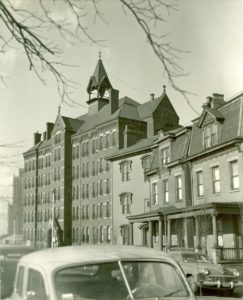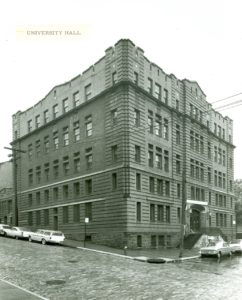
10/26/17
By Ollie Gratzinger | Features Editor
Well, folks, it’s that time of year again.
The weather has finally turned, and the air, tinged with autumn’s chilly bite, carries in it the promise of impending winter. ‘Tis the season for hayrides and hand-carved jack-o-lanterns, candied apples and ghost stories around the fire.
Unfortunately, there’s no fire – though the constant wail of Towers’ alarms might convince you otherwise – but here on the Bluff, we’ve got our fair share of spooky tales of times long past. Thomas White, the university’s archivist, shared a few stories about Duquesne’s haunted history.
An Uncivil War

Passavant Hospital (center) was a stop on the Underground Railroad, where Dr. Albert Walter treated slaves and helped them escape to freedom.
Our first tale takes us back to the 1850s, during which time the land that holds Old Main held instead an old hospital run by Dr. Albert Walter. In the era of Victorian medicine, characterized by bloodletting and leeches, Dr. Walter was something of a marvel, performing orthopedic surgical procedures more closely related to the kind of medicine we might see today. But he was remarkable in another way, too; Dr. Walter was an abolitionist, and his hospital served as a stop on the Underground Railroad.
As the story goes, he was able to help many slaves escape further north, where the promise of a new life awaited them. But one day, there was a man that collapsed on his doorstep, beaten badly and still in shackles. Despite Dr. Walter’s best attempts at saving him, the slave died of his sustained injuries.
A few years later at the outbreak of the Civil War, Dr. Walter began taking in and treating soldiers that were wounded and in need of care beyond what medical camps could offer. He found himself treating a Confederate soldier, and not long after, the soldier died, too.
Dr. Walter died in the 1870s, and his hospital went up for sale. In search of a permanent home, the Holy Ghost Fathers purchased the building in the 1880s. They moved the building a bit, stuck a third story underneath, named it St. John’s Hall and put it near where Bayer Hall is today. Right away, strange things started happening.
From the basement, the sounds of fighting filled the house. It’s been said that the unseen battle was waged between the ghost of the slave that died there and the Confederate soldier that met his end, too. It continued for ages, and eventually, one of the seminarians that called St. John’s home became fed up with the fighting, as it grew in volume and intensity. So he grabbed his holy water and marched down to that basement to let the spirits know who was boss.
“I’m coming down to drive you out,” he declared.
A southern-tinged voice answered him, muttering something to the effect of, “Come ahead, I’m not afraid of you!”
The priest, angered by the spirit’s proclamation, descended into the basement, and the others, too afraid to enter themselves, recalled the sounds of a physical altercation. Holy water was splashing, prayers were being proclaimed and after about a half an hour, the priest emerged. After that, all was quiet.
St. John’s was torn down in the 1970s, but nonetheless, people still claim to see spirits aimlessly wandering around. Among them are the slave that died before knowing freedom and a nurse that roams Old Main’s halls, bringing an uncanny chill to the air.
The Playful Dead
Where Des Places now stands, there once was a different building built in 1909, which housed a variety of things from ROTC to The Duquesne Duke. Before it was purchased by the university, though, it was the Old Newsboys’ Home, a short-lived orphanage operating at the height of the Spanish Flu epidemic.
A few boys died there, and yet it’s possible that they remained even after the orphanage shut down and Duquesne moved in.

Much of DU’s haunted history comes out of the original Des Places, or University Hall, as pictured above.
One editor of The Duke, working late, was alone in the pressroom. He had his things laid out on his desk when he stepped out for a drink, but when he returned, everything was rearranged on a different table.
Another Duke staffer told of a time when they, too, were alone and peered around the corner to see a little boy peeking back at them.
Is it the ghost of a youngster that died of disease in the orphanage? Or is it the ceaseless fatigue that comes with putting out a weekly paper that led the writers’ eyes to deception?
Being that the building was torn down and replaced with Des Places dormitory, where nothing strange has ever happened, I suppose we’ll never know.
The Ghost of Fisher Café
Fisher Hall was probably always an unreasonable maze, but like other buildings, it has a history predating its use as a class space. It once held Fisher Café, a small restaurant with a big penchant for the uncanny.
Workers there would report screaming coming from empty hallways, phantom footsteps and slamming doors.
It escalated, and a priest was asked to come in and bless the building. Before he could, though, a manager had come into Fisher Café, still turned around in conversation with a member of the cleaning staff when she reached around the corner to flip on the light switch.
A cool breath came against her hand, and a voice rasped out, “Don’t turn it on.”
She screamed and ran to the cleaning man, and when they entered the space together, everything inside had been blown around by what seemed to have been a wind that came from nowhere.
Another member of the cleaning staff saw a guy in a brown suit walk out of a room on the top floor late at night, and when they saw him walk down the hallway and vanish into another room, they followed to find that the room was, in fact, empty.
The priest came and blessed the building, and Fisher Hall went quiet.
Until recently.
Dead Doorman
The construction of the Fisher skywalk reawakened something unseen.
Folks entering the building on the Fisher side of the skywalk would make their way toward a smiling old gent, propping open the door with an inviting air of welcome.
However, when they’d turn to thank him, the space would be empty, and the door would be slowly closing. There was no sign of the seemingly well-meaning old man, and on the skywalk, it goes without saying that there’s nowhere to hide.
While these stories are believed by many over the ages, Tom White says that whether you think they’re true or not isn’t entirely the point. The point, instead, is that tales such as these remind us of Duquesne’s history, of a narrative in which we can all take part.
“The Spiritans also play a role in these stories. Some of it remembers the Catholic identity of the school,” White said. “Even the Old Main story shows the early years, when people didn’t want a Catholic college in Pittsburgh, they were dealing with financial trouble and anti-Catholic stuff and all that. So why not throw a ghost in there to fight, too?”




